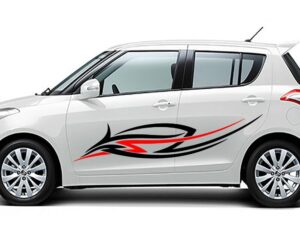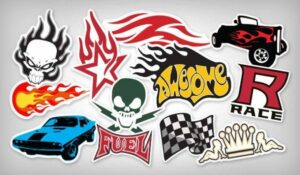Types of car stickers
- Bumper stickers: These are usually placed on the rear bumper of a car and can feature political slogans, funny quotes, or personal expressions.
- Window stickers: These can be placed on the rear window or side windows of a car and can feature brand logos, sports team logos, or personal messages.
- Decals: These are larger stickers that can be placed on the hood or side of a car and often feature graphic designs or images.
- Vinyl lettering: These are individual letters or words that can be applied directly to a car’s paint job or windows, often used for advertising or personal expression.
- Family stickers: These are stickers that depict family members, pets, or hobbies and are usually placed on the rear window of a car.
- Country or state flags: These are stickers that depict a specific country or state flag and are often used to show national or state pride.
- Custom stickers: These are stickers that can be designed and printed to feature any message or image, often used for advertising or personal expression.
Bumper stickers:
Bumper stickers are adhesive labels or stickers that are placed on the bumper of a car. They are typically made of vinyl or paper and are designed to be weather-resistant and durable. Bumper stickers are often used to express personal beliefs or political views, promote businesses or organizations, or share humorous or inspirational messages.
Bumper stickers first became popular in the 1950s and 1960s as a way for people to express their support for political candidates and causes. Over time, bumper stickers have evolved to include a wide range of messages and designs, from humorous slogans and pop culture references to personal statements and artistic designs.
Bumper stickers can be easily applied to a car’s bumper or other smooth surfaces, and can also be removed without damaging the paint or leaving residue. However, it’s important to note that some states and municipalities have laws governing the placement of bumper stickers on cars, so it’s important to check local regulations before applying a sticker to your car’s bumper.
Window stickers:
Stickers on car windows are a popular way for people to express themselves or promote something. They are usually made of vinyl and are designed to be weather-resistant and durable. Car window stickers can be applied to the rear window or side windows of a car, and they can feature a variety of designs and messages.
Some common types of car window stickers include:
- Brand logos: Car window stickers can feature logos of popular brands, such as sports teams, clothing companies, or tech companies.
- Political or social messages: Car window stickers can be used to express political or social views on issues such as climate change, human rights, or animal welfare.
- Personal expressions: Car window stickers can be used to express personal interests or hobbies, such as music, sports, or travel.
- Family stickers: These are stickers that depict family members, pets, or hobbies and are usually placed on the rear window of a car.
- Promotional stickers: Car window stickers can be used for promotional purposes, such as advertising a business, event, or cause.
It’s important to note that some states and municipalities have laws governing the placement of stickers on car windows, so it’s important to check local regulations before applying a sticker to your car’s windows. Additionally, it’s important to ensure that the placement of the sticker does not obstruct the driver’s view or violate any safety regulations.
Vinyl lettering:
Vinyl lettering on a car refers to the process of applying custom letters or designs made of vinyl to the car’s surface. This is often done for personal expression or for advertising purposes. Vinyl lettering is buydo.eu a popular choice because it is durable, weather-resistant, and can be easily applied to any smooth surface on the car, such as the windows, doors, or even the body.
Some common uses of vinyl lettering on cars include:
- Business advertising: Vinyl lettering can be used to display a business name, logo, or contact information on a car for advertising purposes.
- Personal expression: Vinyl lettering can be used to display a personal message, quote, or design on a car to express individuality or to commemorate an event.
- Racing stripes: Vinyl lettering can be used to create custom racing stripes on a car, adding a sporty or racing look.
- Car club logos: Vinyl lettering can be used to display the logo of a car club or group, showing support and camaraderie.
It’s important to note that when applying vinyl lettering to a car, it’s important to use high-quality vinyl and to ensure that the surface is clean and dry before applying the letters. It’s also important to follow the manufacturer’s instructions for application and to ensure that the lettering is applied in a straight and level manner.

Family stickers:
Family car stickers, also known as family car decals or family car graphics, are a popular way for families to express their personalities and show off their family structure. Here are some types of family car stickers:
- Stick Figure Family Stickers: Stick figure family stickers are the most popular type of family car sticker. They consist of stick figure figures representing family members, pets, and hobbies.
- Pet Family Stickers: Pet family stickers are similar to stick figure family stickers but include images of family pets.
- Sports Family Stickers: Sports family stickers are a popular option for families who enjoy sports. They feature images of family members engaged in various sports activities, such as soccer, football, and basketball.
- Custom Family Stickers: Custom family stickers allow families to create unique designs that reflect their personalities and interests. They can include family names, messages, and graphics that represent hobbies, interests, or careers.
When choosing family car stickers, consider the size and placement of the sticker on the car. Stickers that are too large or placed in the wrong location can obstruct the driver’s view or violate local laws. Also, consider the quality of the sticker material and adhesive to ensure that it will last and not damage the car’s paint when removed. Finally, choose a design that reflects your family’s interests and personalities and that you will enjoy seeing on your car every day.
Country or state flags:
Flags of countries or states on cars are a popular way for drivers to show pride in their heritage, nationality, or state of residence. Here are some considerations when choosing and displaying flag stickers on cars:
- Size and Placement: The size and placement of the flag sticker on the car are essential. The sticker should not obstruct the driver’s view or violate any local laws or regulations.
- Material and Quality: The material and quality of the sticker are also important. High-quality stickers will last longer and resist fading or peeling in harsh weather conditions.
- Country or State: Consider the country or state that you want to represent on your car. You can choose to display the flag of your country of origin or the state you live in, or both.
- Personal Meaning: The flag sticker you choose may have personal meaning to you. It could be a symbol of your heritage or a way to show support for a particular cause or movement.
- Respect: When displaying a flag sticker on your car, it’s important to show respect for the flag and what it represents. Avoid using damaged or disrespectful images of flags, and be mindful of any cultural or political sensitivities associated with the flag.
Overall, displaying flag stickers on cars can be a great way to show pride in your heritage, nationality, or state of residence. Choose a high-quality sticker that reflects your personal meaning and show respect for the flag and what it represents.
Custom car stickers
Custom car stickers are stickers that are designed and printed to feature any message, image, or design that the customer desires. These stickers can be made in various sizes, shapes, and colors, and can be printed on a range of materials, such as vinyl, paper, or plastic.
Custom car stickers are popular for personalizing cars, promoting businesses or events, or creating awareness for a particular cause or campaign. They can be designed using custom fonts, graphics, logos, or photos, making them truly unique and eye-catching.
The process of ordering custom car stickers typically involves selecting a design, specifying the size and quantity of the stickers, and choosing the material for printing. Many companies that specialize in custom car stickers offer online design tools that allow customers to create and preview their designs before placing an order.
When applying custom car stickers, it’s important to ensure that the surface is clean and dry, and that the sticker is placed in a position that is easily visible without obstructing the driver’s view. It’s also important to follow any local regulations or laws regarding the placement of stickers on cars.
How to carefully apply a sticker on a car – recommendations
Here are some recommendations for carefully applying a sticker on a car:
- Clean the Surface: Before applying the sticker, make sure the surface of the car is clean and dry. Use a mild detergent and water to clean the area where you want to apply the sticker, and let it dry completely.
- Prepare the Sticker: Carefully remove the sticker from its backing, making sure that the adhesive side is facing up. If the sticker is large, you may want to cut it into smaller sections to make it easier to handle.
- Position the Sticker: Carefully position the sticker on the car where you want it to be. You can use a small piece of tape to hold the sticker in place while you check the placement.
- Apply the Sticker: Once you are satisfied with the position of the sticker, use a squeegee or credit card to apply pressure and smooth out any bubbles or wrinkles. Start from the center and work your way outwards, being careful not to stretch or distort the sticker.
- Remove the Transfer Tape: After you have applied the sticker, slowly and carefully remove the transfer tape, starting from one corner and working your way across the sticker. Be careful not to pull the sticker away from the car.
- Allow to Settle: After applying the sticker, avoid washing the car or exposing it to rain or other moisture for at least 24 hours to allow the sticker to settle properly.
By following these recommendations, you can carefully apply a sticker on a car and ensure it looks great and lasts a long time.
